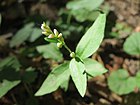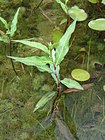Note: This is a project under development. The articles on this wiki are just being initiated and broadly incomplete. You can Help creating new pages.
Difference between revisions of "Polygonum hydropiper"
(Created page with "{{stub}} ==Uses== {{Uses|}}, {{Uses|}}, {{Uses|}}, {{Uses|}}, {{Uses|}}, {{Uses|}}, {{Uses|}}, {{Uses|}}, {{Uses|}}, {{Uses|}}, {{Uses|}}.<ref name="Uses"/> ==Parts Used== {{...") |
|||
| (One intermediate revision by the same user not shown) | |||
| Line 1: | Line 1: | ||
| − | + | [[File:Persicaria hydropiper leaves.JPG|thumb|right]] | |
| + | '''Polygonum hydropiper''' is an annual plant that can grow up to 0.75 metres tall. It is harvested from the wild for local use as a food, medicine and source of materials. | ||
==Uses== | ==Uses== | ||
| − | {{Uses|}}, {{Uses|}}, {{Uses|}}, {{Uses|}}, {{Uses|}}, {{Uses|}}, {{Uses|}}, {{Uses|}}, {{Uses|}}, {{Uses|}}, {{Uses|}}.<ref name="Uses"/> | + | {{Uses|Bleeding}}, {{Uses|Skin problems}}, {{Uses|Diarrhoea}}, {{Uses|Bleeding}}, {{Uses|Dyspepsia}}, {{Uses|Itching skin}}, {{Uses|Haemorrhoids}}, {{Uses|Swollen}}, {{Uses|Inflamed areas}}, {{Uses|Piles}}, {{Uses|Menstrual pains}}.<ref name="Uses"/> |
==Parts Used== | ==Parts Used== | ||
| − | {{Parts Used|}}, {{Parts Used| | + | {{Parts Used|Leaves}}, {{Parts Used|Stems}}, {{Parts Used|Seeds}}. |
==Chemical Composition== | ==Chemical Composition== | ||
| − | <ref name="chemical composition"/> | + | It contains flavonoids, quinones, phenylpropanoids, and terpenoids, which show anticancer, antitumor, anti-oxidative, anti-inflammatory, analgesic, antibacterial, insecticidal etc.<ref name="chemical composition"/> |
==Common names== | ==Common names== | ||
| − | {{Common names|sa=|en=|gu=|hi=|kn=|ks=|ml=|mr=|pa=|ta=|te=}} | + | {{Common names|sa=|en=Water Pepper, Marsh-pepper smartweed|gu=|hi=|kn=Kari agrada gida|ks=|ml=|mr=|pa=|ta=|te=}}<ref name="Common names"/> |
==Properties== | ==Properties== | ||
| Line 16: | Line 17: | ||
===Dravya=== | ===Dravya=== | ||
===Rasa=== | ===Rasa=== | ||
| − | |||
===Guna=== | ===Guna=== | ||
| Line 48: | Line 48: | ||
==Mode of Propagation== | ==Mode of Propagation== | ||
| − | {{Propagation|}} | + | {{Propagation|Seeds}} |
==How to plant/cultivate== | ==How to plant/cultivate== | ||
| − | <ref name="How to plant/cultivate"/> | + | A water plant, growing in shallow water or wet soils. Succeeds in most soils if they are wet and dislikes shade.<ref name="How to plant/cultivate"/> |
==Commonly seen growing in areas== | ==Commonly seen growing in areas== | ||
| − | {{Commonly seen|}}, {{Commonly seen| | + | {{Commonly seen|Shallow water in ponds}}, {{Commonly seen|Ditches}}. |
==Photo Gallery== | ==Photo Gallery== | ||
<gallery class="left" caption="" widths="140px" heights="140px"> | <gallery class="left" caption="" widths="140px" heights="140px"> | ||
| − | + | 20170823Persicaria hydropiper.jpg | |
| + | 20150804Persicaria hydropiper6.jpg | ||
| + | 20150804Persicaria hydropiper2.jpg | ||
| + | 20170819Persicaria hydropiper2.jpg | ||
| + | Persicaria hydropiper leaves.JPG | ||
| + | Polygonum hydropiper eu 76 14062008 1.jpg | ||
</gallery> | </gallery> | ||
| Line 64: | Line 69: | ||
<references> | <references> | ||
| − | <ref name="chemical composition">[ | + | <ref name="chemical composition">[https://www.researchgate.net/publication/298264640_Study_on_chemical_constituents_of_Polygonum_hydropiper_Linn Chemical constituents]</ref> |
| − | <ref name="Leaf">[" | + | <ref name="Leaf">[Morphology]</ref> |
| + | <ref name="Common names">[https://www.flowersofindia.net/catalog/slides/Water%20Pepper.html#:~:text=Flower%20spikes%20more%20than%203,in%20other%20parts%20of%20India. Common names]</ref> | ||
| − | <ref name="How to plant/cultivate">[ | + | <ref name="How to plant/cultivate">[http://temperate.theferns.info/plant/Polygonum+hydropiper Cultivation]</ref> |
<ref name="Uses">Indian Medicinal Plants by C.P.Khare</ref> | <ref name="Uses">Indian Medicinal Plants by C.P.Khare</ref> | ||
</references> | </references> | ||
==External Links== | ==External Links== | ||
| − | * [ ] | + | * [https://www.flowersofindia.net/catalog/slides/Water%20Pepper.html#:~:text=Flower%20spikes%20more%20than%203,in%20other%20parts%20of%20India. Polygonum hydropiper on flowersofindia.net] |
| − | * [ ] | + | * [https://www.ncbi.nlm.nih.gov/pmc/articles/PMC4009190/ Polygonum hydropiper on ncbi.nlm.nih.gov] |
| − | * [ ] | + | * [http://www.naturalmedicinalherbs.net/herbs/p/polygonum-hydropiper=smartweed.php Polygonum hydropiper on naturalmedicinalherbs.net] |
[[Category:Herbs]] | [[Category:Herbs]] | ||
| + | [[Category:Pages without herbs images]] | ||
Latest revision as of 18:02, 8 July 2020
Polygonum hydropiper is an annual plant that can grow up to 0.75 metres tall. It is harvested from the wild for local use as a food, medicine and source of materials.
Contents
- 1 Uses
- 2 Parts Used
- 3 Chemical Composition
- 4 Common names
- 5 Properties
- 6 Habit
- 7 Identification
- 8 List of Ayurvedic medicine in which the herb is used
- 9 Where to get the saplings
- 10 Mode of Propagation
- 11 How to plant/cultivate
- 12 Commonly seen growing in areas
- 13 Photo Gallery
- 14 References
- 15 External Links
Uses
Bleeding, Skin problems, Diarrhoea, Bleeding, Dyspepsia, Itching skin, Haemorrhoids, Swollen, Inflamed areas, Piles, Menstrual pains.[1]
Parts Used
Chemical Composition
It contains flavonoids, quinones, phenylpropanoids, and terpenoids, which show anticancer, antitumor, anti-oxidative, anti-inflammatory, analgesic, antibacterial, insecticidal etc.[2]
Common names
| Language | Common name |
|---|---|
| Kannada | Kari agrada gida |
| Hindi | |
| Malayalam | |
| Tamil | |
| Telugu | |
| Marathi | |
| Gujarathi | |
| Punjabi | |
| Kashmiri | |
| Sanskrit | |
| English | Water Pepper, Marsh-pepper smartweed |
Properties
Reference: Dravya - Substance, Rasa - Taste, Guna - Qualities, Veerya - Potency, Vipaka - Post-digesion effect, Karma - Pharmacological activity, Prabhava - Therepeutics.
Dravya
Rasa
Guna
Veerya
Vipaka
Karma
Prabhava
Habit
[[:Category:Habit - |]]
Identification
Leaf
| Kind | Shape | Feature |
|---|---|---|
Flower
| Type | Size | Color and composition | Stamen | More information |
|---|---|---|---|---|
| {{{5}}} |
Fruit
| Type | Size | Mass | Appearance | Seeds | More information |
|---|---|---|---|---|---|
Other features
List of Ayurvedic medicine in which the herb is used
Where to get the saplings
Mode of Propagation
How to plant/cultivate
A water plant, growing in shallow water or wet soils. Succeeds in most soils if they are wet and dislikes shade.[5]
Commonly seen growing in areas
Shallow water in ponds, Ditches.
Photo Gallery
References
- ↑ Indian Medicinal Plants by C.P.Khare
- ↑ Chemical constituents
- ↑ Common names
- ↑ [Morphology]
- ↑ Cultivation
External Links
- Ayurvedic Herbs known to be helpful to treat Bleeding
- Ayurvedic Herbs known to be helpful to treat Skin problems
- Ayurvedic Herbs known to be helpful to treat Diarrhoea
- Ayurvedic Herbs known to be helpful to treat Dyspepsia
- Ayurvedic Herbs known to be helpful to treat Itching skin
- Ayurvedic Herbs known to be helpful to treat Haemorrhoids
- Ayurvedic Herbs known to be helpful to treat Swollen
- Ayurvedic Herbs known to be helpful to treat Inflamed areas
- Ayurvedic Herbs known to be helpful to treat Piles
- Ayurvedic Herbs known to be helpful to treat Menstrual pains
- Herbs with Leaves used in medicine
- Herbs with Stems used in medicine
- Herbs with Seeds used in medicine
- Herbs with common name in Kannada
- Herbs with common name in English
- Habit -
- Index of Plants which can be propagated by Seeds
- Herbs that are commonly seen in the region of Shallow water in ponds
- Herbs that are commonly seen in the region of Ditches
- Herbs
- Pages without herbs images






